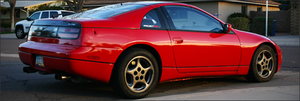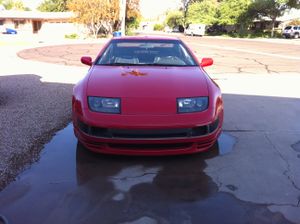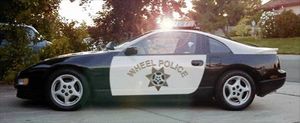Buyer's Guide
Shopping for the Z32 of your dreams?
The 1990-1996 Nissan 300ZX is a bit of a difficult car to shop for. Prices range from $1000 to over $20,000 USD, depending on the condition. Turbo or Naturally Aspirated, 2+2 or convertible, there is a range in cars available for the potential Z buyer. It can be a little overwhelming. In effort to make this a little easier, this guide aims to give shoppers a keen eye on what to look for when trying to find a new Z32 to care and feed!
Narrowing Down Your Search
Location Location Location
Aside from the usual places, like craigslist and autotrader, there are a few dedicated forums that are often good places to look for Z32s.
- TwinTurbo.NET (Requires registration and a certain amount of "hits" to post in the classifieds, can view immediately).
- 300ZX Club (No classified access for the first 30 days of membership)
- ProjectZ32 (Arizona-focused but international forums)
- NICO Club
Don't be afraid to travel a bit for the right Z32, and by all means take your time when hunting. Check out a few cars in person and get a feel for what a Z32 should feel like before jumping on one. If possible, bring along a friend who's knowledgeable with Nissans or even better, Z32s in particular. Registering at the above forums will also open up connections to local Z clubs, and could potentially get you connected with people who are able to check out cars with/for you.
On Mileage
A lot of people put a lot of emphasis on the importance of a car's mileage. While it can be a good over-all indicator of a car's condition, don't let it be the deciding factor in picking out a Z. The Z32 is not a Corolla, and 150,000 well-cared-for miles are a lot more desirable than 90,000 miles of abuse. The VG30DE(TT), the engine found in the Z32, is a very stout one. Given it's been well-maintained, a Z32 can go for 200,000 or 300,000 miles without much drama. It's all about the previous owner(s).
Motor Swaps & Rebuilds
If you come across a listing saying the engine was recently rebuilt, use discretion. A recently-rebuilt engine could have been botched and just be the owner trying to dump the problem on someone else. Sometimes disingenuous owners will say a motor's been rebuilt when it's actually only had a minor tune-up, or nothing at all. If someone is insisting on their motor being rebuilt, ask to see receipts of the parts and labor. Further, a rebuilt motor with some miles on it (say, 10,000+) is probably a more solid purchase than one that's JUST been put back together.
On the same note, try to avoid cars which have had their motors swapped. While this can often be a cheap way to get into a twin turbo, the unfortunate reality is most people haven't got a clue what they're doing, and you're likely to end up with a can of worms just waiting to be opened. Many sellers advertise that they've installed a JDM motor, sometimes even going so far to say that JDM motors have more power, or are low mileage. In reality, JDM motors are the same age as their USDM counterparts, and while often do have fewer miles, this number isn't nearly as low as many claim it to be. On top of that, many JDM motors have been used and abused, and are installed as a cheap/easy fix for a blown motor. Besides, they actually don't make any more power than the USDM versions--they're exactly the same. In fact, since many JDM TT cars were automatic, you could be buying a M/T TT with a JDM auto TT motor, which actually makes 20hp LESS than a M/T version! I once looked at a TT Swapped 2+2 which had an unknown auto tranny, N/A fuel pump, N/A ECU, and still had the Tiger Japanese sticker on the timing belt cover.
Of course, there are always exceptions to these rules. If a known trusted mechanic on a large Z32 forum is selling their recent rebuilt or swapped Z, they're probably going to be in pretty good condition.
Accident/Repair Evidence & Body Straightness
It would amaze you how many times I'll see a listing for a Z which has "never been in an accident!" and I can tell from the online listing it has been. There are a common points of damage that can quickly raise some red flags when looking for a Z32. These are faults you should be able to spot just by looking at pictures of the Z online.
- 90-93 Zs had a gray strip painted on the front fascia. In 1994, this strip became body-colored. When the front bumper is replaced or repainted, this strip is almost never repainted. This may indicate that the car has been in an accident at some point.
- On the same note as above, '90s (and just 90s) had a "NISSAN" sticker on that mustache, offset towards the driver's side.
- If the headlights or center nose panel in the front seem to "dip down" on a corner, this often means that the Z has been backed into. This tends to break one of the mounts on the nose panel and/or headlights which causes one corner to sag.
- The fenders, hood, and front bumper are notoriously difficult to align. Uneven body lines here are usually evidence of an accident or body repair, especially the gap between the fenders and front bumper.
- If the hood kind of looks like it's popped even when it's not, this is usually an indication that the car has been jacked up from the radiator core support. This is reparable (and replaceable if you really wanted), but could be an indicator of a less-than-meticulous previous owner.
- The gap between the doors and fenders should be even and straight, too. These tend to be strong indicators of an accident.
- Z32s originally had a black "accent stripe" running in that groove all around the car. If the car has been repainted, shops will often just paint right over this line, and almost never replace it.

- Check to see that the spoiler and front bumper match the model. For example, a twin turbo should have a spoiler (90-93 flushmount, 94-96 "pedestal" type) along with slots in the front fascia for the intercoolers.
- Cars with pearl paints (like Pearl White, Pearl Yellow, etc) are very difficult to match, and discoloration in different body panels is another good indication of accidents and body repair.
- Make sure the wheels aren't on backwards. I see more Zs with backwards wheels than those with correctly installed wheels. This shouldn't be a deal-breaker, but most enthusiasts realize that the wheels are directional.
- Check for factory paint colors. Candy/burnt orange, sky blue, neon green, etc, did not come from the factory. Color changes, especially ugly ones, tend to greatly devalue a car.
- If you can see pictures of the gauge cluster, check to see if it had a boost gauge. Turbo models have a boost gauge integrated into the speedometer. The lack of a boost gauge could indicate that the car was a swap.
Checking Out the Car in Person
Once you've found a Z that ticks all the right boxes, it's time to head down and start kickin' tires!
Check for Rust
- Check the rocker panels, the underside of the car on the sides.
- Pop the hatch and look around the rubber weatherstripping.
- Peel back some of the rear carpet and check the corners, near the tool kit especially.
- If the owner will let you, remove the battery and tray, as leaky batteries tend to DESTROY the area under the tray. Be careful not to damage the windshield cowl when doing so.
Further Body Inspection
- Check the bodywork behind the headlights for winkling and welding, which would indicate accident repair.
- Check the rocker panels for dents, or bends in the pinch welds.
- Check the body gap of ALL body panels: fender to door, fender to hood, bumper to fender, etc.
- Check that the wheel gap between the driver and passenger sides is equal.
Cold Startups & Time of Day
The best time to check out a car is in the morning. It's unlikely that the owner has started the car already, and cold start-ups tend to expose the most flaws with older engines. NEVER check out a car at night--you'll miss all the problems you would see in daylight!
- Zs with leaking valve seals (somewhat common on very early production Z32s) will blow a plume of smoke on initial startup. This is excess oil burning off the spark plugs.
- Squealing might indicate improperly tensioned drive belts.
- Ticking and rattling could indicate incorrect oil weights, dirty oil, tired VTC gears, or failing lifters.
- Metallic whining may indicate a failing oil pump or power steering pump.
- High idle and lazy throttle response when cold usually indicate problems with timing, vacuum leaks, and other misc. electrical faults.
- Chugging/missing when cold is usually an indicator of low compression and/or one or more fuel injectors on their way out.
Test Driving
- Drive it while it's cold, but be nice to it--cold engines shouldn't be run hard. Once it's fully warmed up, give it some throttle and feel for hesitation or bucking. This could point to improper spark plugs/spark plug gap, or failing fuel injectors (among many other potential problems).
- Listen for a clunk from the rear of the car during on/off throttle transitions. This is usually caused by bad differential mounts, which are cheap, but labor-intensive to replace.
- Ensure that the car tracks straight on a level road. If not, it could just need an alignment, or it could have been in an accident.
- Front brake rotors warping and bad tension rod bushings will cause steering wheel shake under braking.
- Improperly balanced tires or a bad driveshaft carrier bearing (on stock driveshafts) can cause vibration at highway speeds.
- A mechanical "ratcheting" sound/feeling can be caused by a bad carrier bearing (stock driveshaft) or bad CV joints in the rear axles.
- Power steering should be relatively light at low speeds, and become progressively stiffer at high speeds. It will always have assist, but it should not be excessively easy or hard at all times.
- Listen for rattles, pinging, and squealing from the engine and its components under acceleration.
- Check for smoke coming from the exhaust. A bit of condensation burning off is normal on cold starts but it should go away.
- Light blue is oil. Bad piston rings, bad valve seals, and bad turbo seals are common causes.
- White is coolant, usually pointing to a bad headgasket.
- Black is fuel, which can be caused by a bad injector, pinched injector O-ring, or improper air/fuel mixture (bad tune if aftermarket, various EFI-related problems)
- Warm idle should be silky smooth under 1,000 RPM. Around 750-850 RPM is the happy zone.
Hints from the Boost Gauge
On Twin Turbo, you can get some clues about the condition of the engine based on the boost gauge.
Thanks to http://www.300zx.co.uk/tech/BuyingZ.htm for these images.
- At warm idle, the needle should be close to the -14 mark, indicating that the engine is pulling strong vacuum.

- If the needle is closer to the middle of the gauge, it may indicate that the engine has several vacuum leaks and/or lower compression.

- Stock boost is about 9.5 PSI. When you give it some foot, make sure the needle goes a little past the half-way mark (on the positive side).

- If it only goes to the half-way mark, this usually indicates that the car is in safety mode, which limits boost to 7 PSI. This is usually an indicator of a bad Detonation Sensor (or det sensor harness).

- If the needle goes way too far, this means the boost has been increased over stock. It'll push you into your seat quite a bit more, but without the proper supporting mods, this can be extremely dangerous for the engine. This should be accompanied by an ECU upgrade, fuel injector upgrade, and preferably an electronic boost controller.

- If the needle won't budge past 0 PSI under hard acceleration, this could indicate a serious problem with one or both of the turbochargers--a seized turbo, stuck wastegate, or giant boost leak.

- If the boost gauge doesn't work, it means it's electrical connector isn't hooked up. If it sits at 0 the entire time, the vacuum line isn't hooked up. Either of these could be an indicator that the seller is trying to hide something (ie seized turbochargers).
Under the Hood
Sometimes the most obvious place to look is the most over-looked...
- Check for broken electrical connectors, wiring repair jobs, etc. Z32 wiring harnesses are notorious for becoming brittle and cracking.
- Check for stock routing of the engine wiring harness. There are various clips and brackets around the engine bay that secure the wiring harness in place, and these are usually disconnected or broken during engine work.
- Insist on performing a compression check on the engine. If you're not sure how to, take it to a Nissan dealership or Z32 specialist to have it done.
- Make sure the radiator still has its cooling fan shroud, and that the original clutch fan is in place--NOT some cheap electric fan; they never cool as much as the stock setup.
- Ask for documentation of performed maintenance. The 60k/120k service should be performed every 60k miles or 48 months--whichever comes first. If this hasn't been done, plan on doing it immediately as the engine's health depends on it. If the seller can't produce proof of its completion, this is a good price-negotiation point. The kit costs over $500 (which gets you the timing belt, idlers, tensioners, water pump, thermostat, and various other hoses and seals) and will often cost over $500 to install if you're not doing it yourself. However, the Z32 uses an interference engine. If a timing belt component breaks, it will destroy the engine.
Interior
- Check for leather paint--dealerships love to paint damaged interior parts.
- If the stereo is still stock, plan on replacing it. They almost all have trouble these days. On the flip-side, don't let an expensive sound-system persuade you, as that's something that can easily be added (or removed) in the future.
- Play with EVERY switch and button. Make sure everything works. Cruise control, climate control, adjustable suspension, mirror control, etc. Everything on the Z32 is electric.
- Check the t-top drain holes in the A-pillars for clogging, rust, leakage, etc.
- Make sure the key works in everything--doors, ignition, glove box, t-tops, and hatch.
- Black and titanium keys are master keys. Red keys are valet keys and will only operate the doors and ignition.
- If you're looking at a TT, make sure the gauge cluster has a boost gauge, and the mirror switch (by the center console) has the "SPORT/TOURING" suspension switch. If not, you're probably sitting in a TT swapped NA chassis.
Payments and Purchasing
After you've found the Z32 of your dreams, the only thing left to do is sign on the dotted line! Just a few works of advice:
- Deals saying "the car is waiting at the shipping center" or requesting Western Union are scams. DON'T buy the car without seeing it in person unless you're buying it from a trusted community member. If it seems too good to be true, it is.
- Most sellers won't create a payment plan on their 20-year-old Datsun... if you don't have cash, consider financing.
- If you decide to finance, credit unions are preferable as they often offer lower interest rates and better membership perks than banks. Many banks (and indeed, many credit unions) won't finance your 20 year old wet dream, anyways.
- If you are financing, avoid unsecured loans (personal loans, lines of credit, etc). Their interest rates are obscenely high.
- Keep in mind that if you finance your Z, virtually all insurance companies will require comprehensive and collision coverage. This varies by state and company, so check with your insurance company.
- Even if you're not financing, a good insurance policy isn't exactly a bad idea!
- Have patience, please! Rush and jump on the first Z you find and you'll probably have years of headaches and frustration ahead of you. Take your time and find a diamond in the rough and you'll have years of happy ownership!
Don't forget to check out the New Owner's Guide once you'd made your purchase!


